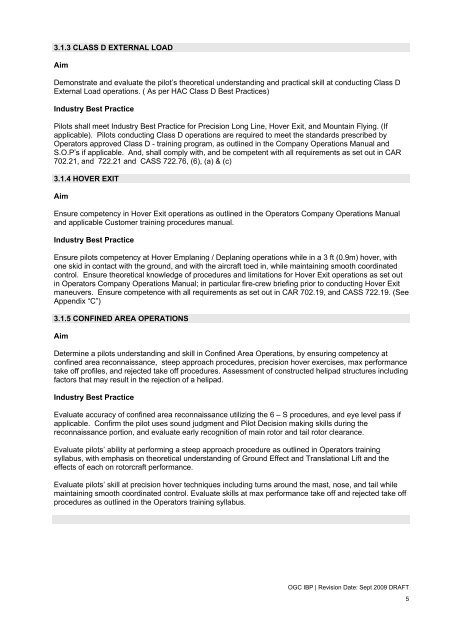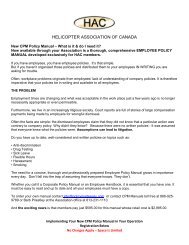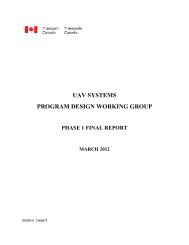HAC Oil & Gas IBP - Helicopter Association of Canada
HAC Oil & Gas IBP - Helicopter Association of Canada
HAC Oil & Gas IBP - Helicopter Association of Canada
You also want an ePaper? Increase the reach of your titles
YUMPU automatically turns print PDFs into web optimized ePapers that Google loves.
3.1.3 CLASS D EXTERNAL LOADAimDemonstrate and evaluate the pilot’s theoretical understanding and practical skill at conducting Class DExternal Load operations. ( As per <strong>HAC</strong> Class D Best Practices)Industry Best PracticePilots shall meet Industry Best Practice for Precision Long Line, Hover Exit, and Mountain Flying. (Ifapplicable). Pilots conducting Class D operations are required to meet the standards prescribed byOperators approved Class D - training program, as outlined in the Company Operations Manual andS.O.P’s if applicable. And, shall comply with, and be competent with all requirements as set out in CAR702.21, and 722.21 and CASS 722.76, (6), (a) & (c)3.1.4 HOVER EXITAimEnsure competency in Hover Exit operations as outlined in the Operators Company Operations Manualand applicable Customer training procedures manual.Industry Best PracticeEnsure pilots competency at Hover Emplaning / Deplaning operations while in a 3 ft (0.9m) hover, withone skid in contact with the ground, and with the aircraft toed in, while maintaining smooth coordinatedcontrol. Ensure theoretical knowledge <strong>of</strong> procedures and limitations for Hover Exit operations as set outin Operators Company Operations Manual; in particular fire-crew briefing prior to conducting Hover Exitmaneuvers. Ensure competence with all requirements as set out in CAR 702.19, and CASS 722.19. (SeeAppendix “C”)3.1.5 CONFINED AREA OPERATIONSAimDetermine a pilots understanding and skill in Confined Area Operations, by ensuring competency atconfined area reconnaissance, steep approach procedures, precision hover exercises, max performancetake <strong>of</strong>f pr<strong>of</strong>iles, and rejected take <strong>of</strong>f procedures. Assessment <strong>of</strong> constructed helipad structures includingfactors that may result in the rejection <strong>of</strong> a helipad.Industry Best PracticeEvaluate accuracy <strong>of</strong> confined area reconnaissance utilizing the 6 – S procedures, and eye level pass ifapplicable. Confirm the pilot uses sound judgment and Pilot Decision making skills during thereconnaissance portion, and evaluate early recognition <strong>of</strong> main rotor and tail rotor clearance.Evaluate pilots’ ability at performing a steep approach procedure as outlined in Operators trainingsyllabus, with emphasis on theoretical understanding <strong>of</strong> Ground Effect and Translational Lift and theeffects <strong>of</strong> each on rotorcraft performance.Evaluate pilots’ skill at precision hover techniques including turns around the mast, nose, and tail whilemaintaining smooth coordinated control. Evaluate skills at max performance take <strong>of</strong>f and rejected take <strong>of</strong>fprocedures as outlined in the Operators training syllabus.OGC <strong>IBP</strong> | Revision Date: Sept 2009 DRAFT5









